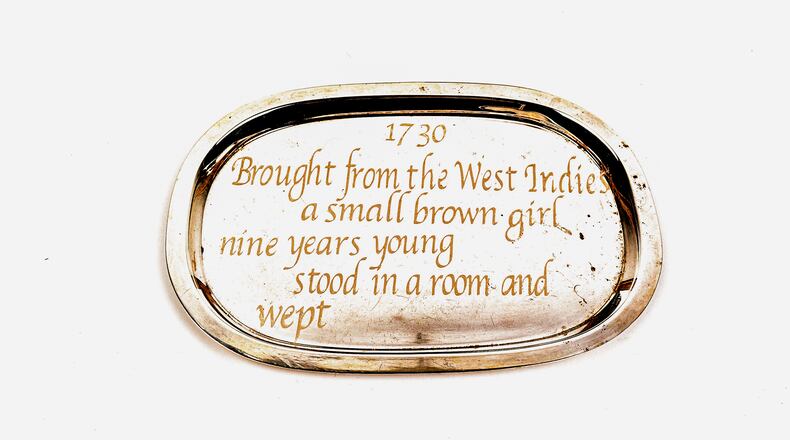“Deborah Dancy: Body of Evidence,” at Marcia Wood Gallery through June 18, is an engaging encounter with a multifaceted artist who probes the nature of abstraction, self and American history.
That is not to say that Dancy stints on the visual. The Alabama-born, Chicago-bred Connecticut artist is best known for the sensuously cerebral abstract paintings displayed in the first gallery. They are concatenations of kinetic lines, broad brush marks and odd shapes, layered as scrims one upon another. Dancy complicates what might be pretty with off-kilter colors like the pinks and greens in “Borders and Boundaries” (2022), which look like Lilly Pulitzer with a stomachache.
Insistent abstractions, they nevertheless call up myriad associations. If the circular shape in “Borders and Boundaries” suggests a portrait, the aqueous expanse in “Evidence to the Contrary” (2021) brings Monet’s water lilies to mind.
Yet, as Dancy said during her artist talk, she likes to leave the viewer at the “edge of understanding.” The periwinkle blue blot in “Blind Faith” (2022) is more like a stop sign. It thwarts the eye’s pathway through translucent layers, almost pushing the viewer away.
Private emotions simmer closer to the surface in “Weight of a Million Black Stars,” her 2020 series of paintings on paper. Each is emblazoned with an energetic black graffiti-like form created with glittery black crushed rock.
Credit: Courtesy of Marcia Wood Gallery
Credit: Courtesy of Marcia Wood Gallery
Dancy explained that George Floyd’s murder inspired the series, compelling her to find a new material (the crushed rock) with which to express her feelings.
The density and grittiness of the material evoked for her the idea of a human body pressed into the asphalt.
But you can feel that intensity without knowing the explanation. To my mind, the vigor and compressed emotion of paintings in this series make them the most memorable of the abstractions here.
Dancy again exploits the symbolism of the color black in the photographs from 2018 in the back gallery. They are stately images of black vessels, each set in a tenebrous ground, elegant containers of . . . what? Pride? Death?
Perhaps the ominous photo in the middle of the series, a pile of ropy braided hair coiled like a snake, answers the question. It certainly points the way to two other pieces in the show: Yes, Macbeth, something wicked this way comes, and it is out in the open, though expressed with typical restraint, in the installation “Domestic Resistance” (2019-22). Here, a group of antique porcelain plates, silver trays, crockery and pewter bearing silhouettes and inscriptions are arrayed on a table, on pedestals and a wall.
The gentility and quaintness suggested at first glance give way to horror on closer examination. The texts evoke the suffering of the enslaved Americans who served the plates and polished the trays, allusions to children separated from parents, people for sale, loneliness and anger.
This is personal. Dancy has devoted considerable time poring over property records and such in Alabama and the Carolinas in search of her enslaved ancestors’ history. Much of her writing, from which she drew the inscriptions, is dedicated to imagining their stories.
Credit: Courtesy of Marcia Wood Gallery
Credit: Courtesy of Marcia Wood Gallery
The personal is political, of course. Dancy’s story is our country’s history, a point she makes in the scathing piece, “The Abridged Currier & Ives Altered Book” (2021). The book is Currier & Ives Printmakers to the American People, a 1942 encomium to the beloved lithographer duo whose wildly popular images of 19th century American life still define an era.
Dancy takes it apart, literally and figuratively. The frayed cover and the book’s dedication page — to “resolute Americans whose sturdy achievement in building an empire” inspired the book’s artists — are displayed in the center of a vitrine. Individual pages, reproductions of individual lithographs, fill the rest of the space. The subject matter is typical Currier & Ives: men fishing, a portrait of George Washington, and so on.
But here comes the sucker punch: an image titled “The Branding of Slaves,” presented as if it were just another American pastime.
Along with the sentimental views of American life and “journalistic” accounts of current events, the lithographers, it turns out, printed many racist images, which were very popular and hung in homes across the continent.
In a sort of controlled burn, Dancy paints over the images, defacing and effacing them, while simultaneously calling attention to the racism embedded in the American psyche. Hopefully, it was a cathartic experience.
If you add up the mysterious abstractions, the explosive “Million Black Stars,” the cryptic photos, the forensic foray into American popular culture, the honoring of ancestors — you’ve got a body of evidence adding up to an impressive career.
The question becomes, why at 73 is Dancy a “new face” to many of us? Marcia Wood learned of her through curator Melissa Messina, who included the artist in “Magnetic Fields,” a 2017 exhibition devoted to abstract art made by unsung — or not enough sung — Black women.
This show makes a compelling case for all that we have yet to discover about American art and ourselves.
Catherine Fox, an award-winning art critic, co-founded ArtsATL.org and served as its executive director and executive editor for five years. Fox was the art critic for the Atlanta Journal Constitution from 1981 to 2009.
Credit: ArtsATL
Credit: ArtsATL
MEET OUR PARTNER
ArtsATL (www.artsatl.org), is a nonprofit organization that plays a critical role in educating and informing audiences about metro Atlanta’s arts and culture. Founded in 2009, ArtsATL’s goal is to help build a sustainable arts community contributing to the economic and cultural health of the city.
If you have any questions about this partnership or others, please contact Senior Manager of Partnerships Nicole Williams at nicole.williams@ajc.com.
About the Author
Keep Reading
The Latest
Featured





